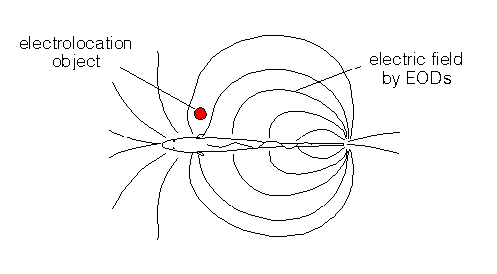Behavioral Neuroscience, lecture on electric fish
Jamming
I. Electric Fish
A. Electrogenic = generate electric fields
1. Electric Organ
a. produces electric fields
b. specialized muscle or nerve cells
i. neuromuscular junction important
ii. produces bioelectric fields stronger
than normal nerves/muscles
iii. electric organ discharge (EOD)
c. Typically this organ is located in the tail
d. Most fish that are electrogenic are also electroreceptive
2. Strongly and Weakly electric fish
a. EOD powerful enough to stun prey = strongly electric fish
i. discharge amplitude: 10 - 600 V
ii. current up to 1 ampere
iii. Examples: Electric eel (Electrophorus electricus)
not a true eel but a knifefish
Electric catfishes (family Malapteruridae)
Electric rays (order Torpediniformes)
b. weakly electric fish EOD for electrolocation and communication
i. navigation, object detection, social interaction
ii. discharge amplitude typically less than 1 V
1) too weak to stun prey
iii. knifefishes, elephantnose
B. Electroreceptive: detect electric fields
1. sharks, skates, rays, catfish, paddle fish,
caecilians, salamaders, platypus
2. not classified as electric fish
a. don't generate an electric field
b. passive electrolocation
3. Electroreceptors vary in sensitivity
a. from 0.005 mV cm-1 to >0.1 mV cm-1
C. Classification - Evolution
1. Electroreception - ancestral vertebrate trait
a. ampullary receptors
b. arisen repeatedly
2. Weakly Electrogenic Fish are distantly related
a. Order Gymnotiformes (New World)
b. Order Mormyridae (Old World)
c. African & S American fish independently evolved electric organs
D. Distribution
1. Ocean - All emit pulses
a. Strongly electric
i. Astroscopus, Torpedo
b. Weakly electric
i. Raja
2. Freshwater Rivers of South America
a. Stongly electric - pulse
i. Electrophorus
b. Weakly electric
i. live in shallow streams of dark, murky waters
ii. nocturnal
1) electric organ most active at night
ii. hunters that feed on insect larvae and small crustaceans
iii. often hide in the aquatic plant life
1) rarely swim in open water
iv. Apteronotus, Eigenmannia (knife fish)
1) emit waves
v. Gymnotus
1) pulses
vi. Sternopygus
1) basal fish in the lineage
3. Freshwater Rivers of Africa
a. Strongly electric - Malapterurus - pulses
b. Weakly electric
i. Gymnarchus - wave
ii. Gnathonemus (elephantnose fish) - pulse
II. Electric organ
A. Location of the organ is species dependent
1. Eigenmannia located in tail
2. Strongly electric fish
a. numerous electrocytes = high voltage discharge
B. Electrocytes - columns of modified muscle cells
1. electrically excitable cells
a. modified sodium channel proteins
i typically used in muscle contraction
2. receive simultaneous Action Potentials from brain
3. asymmetrically polarized
i. like serially connected capacitors
ii. simultaneous firing of electrocytes
1) final EOD unit potential = sum of individual electrocytes: V = n×Vn
iii. electric organ discharges emitted into the surrounding water
III. Electric Organ Discharge - EOD
A. EOD waveforms - 2 species dependent types
1. continuous sinusoidal
a. wave-type EOD
i. genera Apteronotus, Eigenmannia and Gymnarchus
b. weakly electric fish
i. Frequency range of 250-600 Hz
c. fixed frequency
i. continuous AC electricity
2. brief pulses separated by longer gaps
a. pulse-type EOD
i. all strongly + some weakly electric fish
1) Gnathonemus, Gymnotus, Raja
ii. what advantage does a pulse have?
B. Electric field surrounds body
1. dissipate
2. differential output head to tail
a. e.g. abdominal vs caudal electric organs
C. Electroreceptivity
1. Produce and Sense electricity
2. sensitive electroreceptors embedded in the skin
a. detect slight changes in electric field
i. caused by nearby objects including living creatures
3. Electrical "Echo"location
a. requires a combination of electrogeneric
and electroceptive capacity
D. EOD functions
1. Strongly electric fish
a. stun and capture prey
b. even large animals
i. electric eel
2. Weakly electric fish
a. Aids in location of objects (electrolocation)
i. nearby objects distort electric field
b. Foraging
i. areas with low-visibility
ii. find prey under sand (oceanic foraging)
c. Disorient or confuse potential prey
d. Spatial orientation
i.interaction with Earth's magnetic field (electroorientation)
1) determine location and/or surroundings
2) feel its environment
e. Social communication
i. social dominance, territoriality, reproduction
f. Sensation of weather
i. may aid in foraging
g. Sensation of time of day
i. EOD amplitudes vary in circadian pattern
h. Sensation of earthquakes
D. Jamming Avoidance ResponseWatanabe and Takeda 1963
1. Encounters with other fish
a. similar frequency EODs hinder function
i. e.g. electrolocation
2. wave-type electric fish normally discharge at a fixed frequency
a. Each individual has its own frequency of discharge
3. changed EOD frequency to avoid jamming
a. determine difference in frequency and adjust accordingly
i. until frequencies are separated enough for normal electrolocation
b. species dependent
i. Sternopygus
1) Lacks JAR (basal)
ii. Apteronotidae
1) JARs with only ñ EOD frequency
iii. Eigenmannia
1) JARs with ñ or ò EOD frequency
4. Higher order functions
a. temporal and spatial pattern recognition
b. feature detection
c. distributed computation of sensory information
